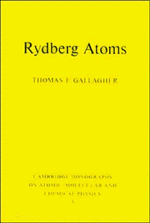Book contents
- Frontmatter
- Contents
- Preface
- 1 Introduction
- 2 Rydberg atom wavefunctions
- 3 Production of Rydberg atoms
- 4 Oscillator strengths and lifetimes
- 5 Black body radiation
- 6 Electric fields
- 7 Pulsed field ionization
- 8 Photoexcitation in electric fields
- 9 Magnetic fields
- 10 Microwave excitation and ionization
- 11 Collisions with neutral atoms and molecules
- 12 Spectral line shifts and broadenings
- 13 Charged particle collisions
- 14 Resonant Rydberg–Rydberg collisions
- 15 Radiative collisions
- 16 Spectroscopy of alkali Rydberg states
- 17 Rf spectroscopy of alkaline earth atoms
- 18 Bound He Rydberg states
- 19 Autoionizing Rydberg states
- 20 Quantum defect theory
- 21 Optical spectra of autoionizing Rydberg states
- 22 Interseries interaction in bound states
- 23 Double Rydberg states
- Index
15 - Radiative collisions
Published online by Cambridge University Press: 29 September 2009
- Frontmatter
- Contents
- Preface
- 1 Introduction
- 2 Rydberg atom wavefunctions
- 3 Production of Rydberg atoms
- 4 Oscillator strengths and lifetimes
- 5 Black body radiation
- 6 Electric fields
- 7 Pulsed field ionization
- 8 Photoexcitation in electric fields
- 9 Magnetic fields
- 10 Microwave excitation and ionization
- 11 Collisions with neutral atoms and molecules
- 12 Spectral line shifts and broadenings
- 13 Charged particle collisions
- 14 Resonant Rydberg–Rydberg collisions
- 15 Radiative collisions
- 16 Spectroscopy of alkali Rydberg states
- 17 Rf spectroscopy of alkaline earth atoms
- 18 Bound He Rydberg states
- 19 Autoionizing Rydberg states
- 20 Quantum defect theory
- 21 Optical spectra of autoionizing Rydberg states
- 22 Interseries interaction in bound states
- 23 Double Rydberg states
- Index
Summary
A radiative collision is a resonant energy transfer collision in which two atoms absorb or emit photons during the collision. Alternatively, a radiative collision is the emission or absorption of a photon from a transient molecule, and, as shown by Gallagher and Holstein, radiative collisions can also be described in terms of line broadening. In a line broadening experiment there are typically many atoms and weak radiation fields, and in a radiative collision experiment there are few atoms and intense radiation fields. The only real difference is whether there are many atoms or many photons. Due to the short collision times, ∼10−12 s, simply observing radiative collisions between low lying states requires high optical powers, and entering the regime where the optical field is no longer a minor perturbation seems unlikely. Due to their long collision times and large dipole moments, Rydberg atoms provide the ideal system in which to study radiative collisions in a quantitative fashion. As we shall see, it is straightforward to enter the strong field regime in which the radiation field, a microwave or rf field to be precise, is no longer a minor perturbation. Ironically, while the experiments are radiative collision experiments, with few atoms and many photons, the description of the strong field regime is given in terms of dressed molecular states, which is more similar to a line broadening description.
- Type
- Chapter
- Information
- Rydberg Atoms , pp. 314 - 339Publisher: Cambridge University PressPrint publication year: 1994



